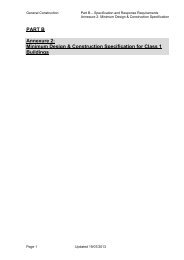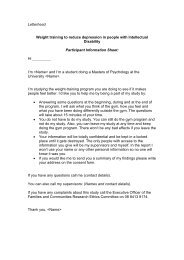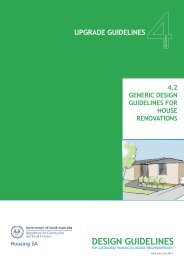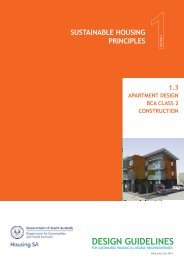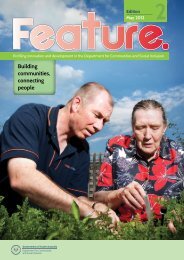2.3 Design Criteria for Adaptable Housing July 2014.indd - DCSI
2.3 Design Criteria for Adaptable Housing July 2014.indd - DCSI
2.3 Design Criteria for Adaptable Housing July 2014.indd - DCSI
Create successful ePaper yourself
Turn your PDF publications into a flip-book with our unique Google optimized e-Paper software.
SUSTAINABLE HOUSING<br />
PRINCIPLES<br />
2SECTION 2<br />
<strong>2.3</strong><br />
HOUSING SA<br />
UNIVERSAL HOUSING<br />
DESIGN CRITERIA<br />
DESIGN GUIDELINES<br />
FOR SUSTAINABLE HOUSING & LIVEABLE NEIGHBOURHOODS<br />
Valid until <strong>July</strong> 2014
DESIGN GUIDELINES<br />
FOR SUSTAINABLE HOUSING & LIVEABLE NEIGHBOURHOODS<br />
2<br />
<strong>2.3</strong> HOUSING SA UNIVERSAL HOUSING<br />
DESIGN CRITERIA<br />
CONTENTS<br />
Copyright 3<br />
Introduction 4<br />
Background 4<br />
Renewal SA 4<br />
This <strong>Design</strong> Guideline 5<br />
Definitions of <strong>Housing</strong> <strong>Design</strong> Approaches 6<br />
Modifications 8<br />
Building Rules and Australian Standards 8<br />
References and Acknowledgements 9<br />
Detailed Requirements 10<br />
Around the House 10<br />
Steps 10<br />
Paths 10<br />
Thresholds 11<br />
Verandahs and Porches 11<br />
Car Parking 11<br />
Inside the House 12<br />
Steps 12<br />
Power points 12<br />
Doors 12<br />
Door handles 12<br />
Living Room, Dining Room and Family Room 13<br />
Corridors 13<br />
Bathroom and Toilet 14<br />
Shower 15<br />
Water Closet (WC) 16<br />
Hand Basin 17<br />
Kitchens 18<br />
Laundry 18<br />
Bedrooms 19<br />
Window <strong>Design</strong> 19<br />
Items Not Required 20<br />
<strong>Housing</strong> Modifications <strong>for</strong> Persons with Disability Policy 21<br />
Examples of Application of <strong>Housing</strong> SA Universal <strong>Housing</strong> 22<br />
<strong>Design</strong> Principles<br />
© Crown Copyright<br />
Government of South Australia<br />
2 <strong>Housing</strong> <strong>Design</strong> Guidelines<br />
Valid until <strong>July</strong> 2014
DESIGN GUIDELINES<br />
FOR SUSTAINABLE HOUSING & LIVEABLE NEIGHBOURHOODS<br />
2<br />
<strong>2.3</strong> HOUSING SA UNIVERSAL HOUSING<br />
DESIGN CRITERIA<br />
Figures & Tables<br />
Figure 1: Example Site Plan 10<br />
Figure 2: Porch door swing clearances 11<br />
Figure 3: Porch door swing clearances 11<br />
Figure 4: Porch door swing clearances 11<br />
Figure 5: <strong>Adaptable</strong> House Carport 11<br />
Figure 6: Universal Heights 12<br />
Figure 7: Door swing clearances and offset requirements 13<br />
Figure 8: Entry Corridor Door Swing Clearances 13<br />
Figure 9: Corridor Door Swing Clearances 13<br />
Figure 10: Corridor Door Swing Clearances 13<br />
Figure 11: Basin set out 14<br />
Figure 12: Shower set out 15<br />
Figure 12a: Stepless shower alcove to larger bathrooms 16<br />
Figure 12b: Stepless shower alcove to smaller bathrooms 16<br />
Figure 13: Toilet set out 16<br />
Figure 14: Vanity Unit Section 17<br />
Figure 15: Vanity unit supported off structure 17<br />
Figure 16: Vanity unit cantilever supported 17<br />
Figure 17: Bedroom Door Swing Clearances 19<br />
Figure 18: Wheelchair Clearances 19<br />
Figure 19: Example of <strong>Housing</strong> SA universal housing requirements 22<br />
Figure 20: Example of <strong>Housing</strong> SA universal housing requirements 22<br />
Table 1: <strong>Housing</strong> SA Swing Door Swing Clearances 13<br />
Copyright<br />
Although <strong>Housing</strong> SA owns copyright on this document on behalf of the Crown, it<br />
licenses its contractors to use the latest available version <strong>for</strong> <strong>Housing</strong> SA design or<br />
construction purposes, and grants non-exclusive licences to others, as long as:<br />
• They do not falsely claim copyright in <strong>Housing</strong> SAs’ work;<br />
• They indemnify <strong>Housing</strong> SA against claims arising from the use of <strong>Housing</strong> SAs’ work.<br />
© Crown Copyright<br />
Government of South Australia<br />
3 <strong>Housing</strong> <strong>Design</strong> Guidelines<br />
Valid until <strong>July</strong> 2014
<strong>2.3</strong> HOUSING SA UNIVERSAL HOUSING DESIGN CRITERIA<br />
2<br />
Introduction<br />
Background<br />
<strong>Housing</strong> SA through its Assets Services Division is the agency within the<br />
Department <strong>for</strong> Communities and Social Inclusion (<strong>Housing</strong> SA) that<br />
supplies housing, asset and policy services to the South Australian <strong>Housing</strong><br />
Trust (SAHT). The SAHT remains the legal owner of the property.<br />
<strong>Housing</strong> SA as part of this service develops and promotes housing that<br />
is af<strong>for</strong>dable and sustainable (socially and environmentally). To help<br />
achieve this <strong>Housing</strong> SA has developed a suite of design guidelines <strong>for</strong><br />
sustainable housing and liveable neighbourhoods that are applicable to<br />
all types of new residential construction, both rental and af<strong>for</strong>dable.<br />
These guidelines represent more than seventy years of SAHT and <strong>Housing</strong><br />
SA experience in providing af<strong>for</strong>dable and rental housing to South<br />
Australians.<br />
The suite of design guidelines comprise the following:<br />
1.1 House <strong>Design</strong> Guide<br />
1.2 Amenity Targets<br />
1.3 Apartment <strong>Design</strong> BCA Class 2 Construction<br />
1.4 <strong>Housing</strong> Accommodation Schedules<br />
2.1 Land Titling and Service Infrastructure<br />
2.2 <strong>Design</strong> Guidelines <strong>for</strong> Site Layouts<br />
<strong>2.3</strong> <strong>Housing</strong> SA Universal <strong>Housing</strong> <strong>Design</strong> <strong>Criteria</strong><br />
2.4 Environmental Sustainability<br />
4.1 <strong>Housing</strong> Modifications<br />
4.2 Generic <strong>Design</strong> Guidelines <strong>for</strong> House Renovations<br />
<strong>Design</strong>ers must understand and incorporate the requirements of these<br />
guidelines. These guidelines assist designers to interpret current policies<br />
and practices and include applicable features of the Good <strong>Design</strong> Guide<br />
SA prepared by Planning SA.<br />
Some design compromise is acceptable to take into account site<br />
constraints and local planning conditions. All designs will be considered<br />
by <strong>Housing</strong> SA on merit. However, the minimum spatial dimensions<br />
needed to meet universal housing living requirements are generally not<br />
negotiable.<br />
Renewal SA<br />
The Urban Renewal Authority now trading as Renewal SA was established<br />
by the state government on the 29 February 2012 to present a fully<br />
integrated approach to urban development. Renewal SA comprises the<br />
<strong>for</strong>mer Land Management Corporation together with the Projects Division<br />
of <strong>Housing</strong> SA and Defence SA.<br />
Renewal SA will also manage many residential projects that involve<br />
land and properties owned by the SAHT. For these projects Renewal SA<br />
must incorporate the requirements of <strong>Housing</strong> SA’s <strong>Design</strong> Guidelines <strong>for</strong><br />
Sustainable <strong>Housing</strong> and Liveable Neighbourhoods.<br />
© Crown Copyright<br />
Government of South Australia<br />
4<br />
<strong>Housing</strong> <strong>Design</strong> Guidelines<br />
Valid until <strong>July</strong> 2014
<strong>2.3</strong> HOUSING SA UNIVERSAL HOUSING DESIGN CRITERIA<br />
2<br />
This <strong>Design</strong> Guideline<br />
This design guideline was previously published as <strong>2.3</strong> <strong>Design</strong> <strong>Criteria</strong><br />
<strong>for</strong> <strong>Adaptable</strong> <strong>Housing</strong>. The name of this guideline has now changed<br />
to <strong>2.3</strong> <strong>Housing</strong> SA Universal <strong>Housing</strong> <strong>Design</strong> <strong>Criteria</strong> to remove<br />
confusion with the definitions of the previously published and<br />
now outdated Australian Standard introduced in 1996 as AS4299<br />
<strong>Adaptable</strong> <strong>Housing</strong>.<br />
This design guideline has been developed as there is a requirement<br />
<strong>for</strong> <strong>Housing</strong> SA to provide housing suitable <strong>for</strong> persons with varying<br />
degrees of disability including wheelchair users. In the past this has<br />
been met by modifying existing housing stock on an ‘as required’<br />
basis. Significant modifications are, however, often very costly.<br />
For this reason, after extensive research of Australian and<br />
International practices, <strong>Housing</strong> SA has adopted a universal housing<br />
design approach which is defined on page 6 that provides <strong>for</strong> both<br />
visitability, and adaptability at the time of construction together<br />
with general <strong>Housing</strong> SA requirements <strong>for</strong> its clients that are<br />
designed to:<br />
• Minimise the current high cost of converting existing houses to<br />
accommodation <strong>for</strong> persons with a disability;<br />
• Enable <strong>Housing</strong> SA to modify houses at minimal cost to allow<br />
tenants in houses designed to this criteria to stay in their own<br />
homes if they become disabled; and<br />
• Enable access by visitors with a disability.<br />
This guideline summarises and provides examples of the key aspects<br />
of the design criteria. It is intended that this guideline is used<br />
as a design tool that provides an overview of what is required so<br />
that builders and designers can assess their existing designs and<br />
either modify or generate new designs that comply with these<br />
requirements.<br />
The principal features of the <strong>Housing</strong> SA universal housing include:<br />
• Stepless entry and enhanced design of doorways;<br />
• Wider circulation at doorways;<br />
• Power points, fixtures, doors and circulation at universal heights<br />
with:<br />
- Door hardware generally 900mm to 1100mm above floor level;<br />
- Wall power outlets 450mm to 600mm above floor level.<br />
• Wider (1500mm) circulation between kitchen benches;<br />
• Bathroom designed to accessibility criteria including:<br />
- stepless shower;<br />
- toilet;<br />
- rein<strong>for</strong>ced wall construction so that grab rails can be fitted<br />
later as an adaptation.<br />
• Carport with widening at side and extended paving;<br />
• 1000mm wide external paving.<br />
© Crown Copyright<br />
Government of South Australia<br />
5<br />
<strong>Housing</strong> <strong>Design</strong> Guidelines<br />
Valid until <strong>July</strong> 2014
<strong>2.3</strong> HOUSING SA UNIVERSAL HOUSING DESIGN CRITERIA<br />
2<br />
To meet the requirements of the Department <strong>for</strong> Communities and<br />
Social Inclusion (<strong>DCSI</strong>) Disability Action Plan, the <strong>Housing</strong> SA building<br />
program is committed to providing a minimum of 75% of all new<br />
houses to be built to meet or exceed the criteria in this guideline.<br />
In recent years the commitment has been com<strong>for</strong>tably exceeded with<br />
only a few two storey projects and some steeply sloping sites not<br />
complying. To enable the adaption of houses to occur there is also<br />
a <strong>Housing</strong> SA maintenance program <strong>for</strong> modification of housing <strong>for</strong><br />
persons with a disability.<br />
In addition <strong>Housing</strong> SA is influencing the wider community and industry<br />
by:<br />
• Promotion, whenever practicable, of sustainable housing<br />
demonstrating that implementation of the <strong>Housing</strong> SA Universal<br />
<strong>Housing</strong> <strong>Design</strong> <strong>Criteria</strong> is both af<strong>for</strong>dable and unobtrusive. The<br />
house designs can be shown to be ‘normal’ and marketable;<br />
• Sponsorship of the housing industry, eg, <strong>Housing</strong> Industry<br />
Association (HIA) and Master Builders Association (MBA), including<br />
housing awards;<br />
• <strong>Housing</strong> SA’s Technical Services professional staff engaging in<br />
proactive participation with Australian Standards and industry<br />
committees and <strong>for</strong>ums;<br />
• Coordination with Planning SA on building rules and control issues.<br />
Ultimately the Planning SA, Building Control Policy Branch has<br />
responsibility <strong>for</strong> any mandatory requirements to provide adaptable,<br />
visitable and accessible housing in South Australia. It controls building<br />
legislative requirements under codes developed by the Australian<br />
Building Codes Board and referenced by Australian Standards, and can<br />
influence house building through mandatory and advisory criteria.<br />
Definitions of <strong>Housing</strong> <strong>Design</strong> Approaches<br />
The following definitions are provided as background in<strong>for</strong>mation and<br />
to allow a greater understanding of the many different approaches<br />
that exist to provide housing to the community.<br />
<strong>Housing</strong> SA Universal <strong>Housing</strong> <strong>Design</strong><br />
Provides <strong>for</strong> both visitability, and adaptability at the time of<br />
construction together with general <strong>Housing</strong> SA requirements <strong>for</strong><br />
its clients. This guideline sets out the design criteria in detail and<br />
has considered and incorporated many of the other housing design<br />
approaches listed below. Implementation of this criteria combined<br />
with the <strong>Housing</strong> SA modification policy ensures that social/welfare<br />
housing is truly universal and can meet almost all of the <strong>Housing</strong> SA<br />
client needs.<br />
Universal <strong>Design</strong><br />
This is a design philosophy that promotes an inclusive ‘design <strong>for</strong><br />
all’ process. The thinking applies to the design of all products from<br />
kitchen utensils to transport and urban planning.<br />
© Crown Copyright<br />
Government of South Australia<br />
6<br />
<strong>Housing</strong> <strong>Design</strong> Guidelines<br />
Valid until <strong>July</strong> 2014
<strong>2.3</strong> HOUSING SA UNIVERSAL HOUSING DESIGN CRITERIA<br />
2<br />
Accessible <strong>Design</strong><br />
Accessibility <strong>for</strong> persons with a disability is achieved by legislative<br />
guidelines driven by codes and standards. Australian Standard<br />
AS1428 mandates requirements applicable to buildings other than<br />
houses.<br />
Visitable <strong>Housing</strong><br />
Is housing that can be accessed by persons with a disability<br />
ensuring that an entry, usually the front door, and access to a<br />
bathroom can be achieved.<br />
<strong>Adaptable</strong> <strong>Housing</strong><br />
Is a generic term <strong>for</strong> housing that incorporates provision <strong>for</strong><br />
inexpensive modifications to houses that can be adapted to meet<br />
particular needs of a resident with a disability.<br />
Livable <strong>Housing</strong><br />
The Australian Government through its Department of Families,<br />
<strong>Housing</strong>, Community Services and Indigenous Affairs has<br />
implemented a Livable <strong>Housing</strong> <strong>Design</strong> Initiative that proposes<br />
a range of requirements <strong>for</strong> housing. The requirements are<br />
pitched at three levels of compliance; silver, gold and platinum,<br />
and is now administered by a separate organization called<br />
Livable <strong>Housing</strong> Australia. The requirements of this initiative are<br />
voluntary only but may be mandated <strong>for</strong> certain projects that are<br />
financed directly with Commonwealth funds.<br />
In general the <strong>Housing</strong> SA Universal <strong>Housing</strong> <strong>Design</strong> <strong>Criteria</strong><br />
guideline meets the intent of the Livable <strong>Housing</strong> <strong>Design</strong><br />
Initiative.<br />
<strong>Housing</strong> <strong>for</strong> Life<br />
The Master Builders Association (MBA) of the Australian Capital<br />
Territory has developed a guide <strong>for</strong> “<strong>Housing</strong> <strong>for</strong> Life” with<br />
funding provided under the Commonwealth Government’s Veteran<br />
& Community Grants scheme operated by the Department of<br />
Veterans’ Affairs.<br />
Lifetime Homes<br />
Proposed by Joseph Rowntree Foundation and incorporating<br />
requirements of Part M of the Building Regulations in England<br />
which provide <strong>for</strong> visitable and accessibility in new residential<br />
construction.<br />
Barrier Free<br />
Lifetime Homes concepts applicable to housing in Scotland.<br />
© Crown Copyright<br />
Government of South Australia<br />
7<br />
<strong>Housing</strong> <strong>Design</strong> Guidelines<br />
Valid until <strong>July</strong> 2014
<strong>2.3</strong> HOUSING SA UNIVERSAL HOUSING DESIGN CRITERIA<br />
2<br />
Modifications<br />
<strong>Housing</strong> SA also has a program <strong>for</strong> modification of housing <strong>for</strong> persons<br />
with a disability which is used to implement further adaptation that<br />
can be easily and inexpensively applied to new housing built to the<br />
<strong>Housing</strong> SA Universal <strong>Housing</strong> <strong>Design</strong> <strong>Criteria</strong>. This include features<br />
such as provision of handrails.<br />
The program also identifies options and techniques that can be<br />
applied to modify older house types. However, there are often<br />
significant structural impediments to basic modifications. In<br />
particular, widening narrow openings and eliminating steps by<br />
means of ramps can be problematic. Extensive modification to<br />
older housing can be both socially disruptive and cost prohibitive,<br />
so relocation to a newer house built to the <strong>Housing</strong> SA Universal<br />
<strong>Housing</strong> <strong>Design</strong> <strong>Criteria</strong> may be a preferable option.<br />
Refer to the design guideline 4.1 <strong>Housing</strong> Modifications <strong>for</strong> further<br />
details.<br />
Building Rules and Australian Standards<br />
Building Code of Australia<br />
All building work in South Australia must be in accordance with<br />
rules set out in the Building Code of Australia (BCA) managed by<br />
the Australian Building Codes Board. Residential construction is<br />
generally in accordance with BCA class 1 and class 2 construction.<br />
Residential construction is initiated and managed by <strong>Housing</strong> SA<br />
on land owned by the SAHT.<br />
Whilst there are no mandatory requirements <strong>for</strong> access to persons<br />
with a disability within the dwellings in these construction<br />
classes, there will be requirements <strong>for</strong> complying with AS1428 <strong>for</strong><br />
access in the foyers and common areas associated with class 2<br />
buildings.<br />
<strong>Design</strong> <strong>for</strong> Access and Mobility AS1428.1<br />
The requirements of Australian Standard AS1428.1 <strong>Design</strong> <strong>for</strong><br />
Access and Mobility apply to all buildings with the exception of<br />
class 1 and class 2 residential development. These requirements<br />
apply to buildings which are work places, institutions and in any<br />
<strong>for</strong>m are publicly accessible.<br />
Nevertheless these standards may be called upon in certain<br />
<strong>Housing</strong> SA “Special Needs” projects to meet particular client<br />
requirements or expectations.<br />
© Crown Copyright<br />
Government of South Australia<br />
8<br />
<strong>Housing</strong> <strong>Design</strong> Guidelines<br />
Valid until <strong>July</strong> 2014
<strong>2.3</strong> HOUSING SA UNIVERSAL HOUSING DESIGN CRITERIA<br />
2<br />
<strong>Adaptable</strong> <strong>Housing</strong> AS4299<br />
This Australian Standard AS4299 <strong>Adaptable</strong> <strong>Housing</strong> is not<br />
mandatory and is now dated. It is currently subject to review,<br />
however Schedule C has recently been applied to a proportion of<br />
new constructed housing, financed by the Commonwealth under<br />
the recent Nation Building Scheme. This standard does cross<br />
reference other standards and in following those cross references,<br />
the version of other standards that was applicable at the time of<br />
publishing AS4299, should be used.<br />
<strong>Housing</strong> SA is confident that its own housing built in accordance<br />
with the <strong>Housing</strong> SA Universal <strong>Housing</strong> <strong>Design</strong> <strong>Criteria</strong> will provide<br />
the users with an equivalent level of access and adaptability in all<br />
housing.<br />
References and Acknowledgements<br />
Australian Standard AS1428.1 <strong>Design</strong> <strong>for</strong> Access and Mobility<br />
Australian Standard AS4299 <strong>Adaptable</strong> <strong>Housing</strong><br />
Welcome - <strong>Design</strong> Ideas <strong>for</strong> Accessible Homes, Building Commission<br />
of Victoria 2002<br />
Minister’s Specification SA F1.7 (<strong>July</strong> 2004) - Waterproofing of wet<br />
areas in buildings - Additional requirements<br />
Australian Standard AS/NZS 2890.1 Parking facilities Part 1: Off<br />
street car parking<br />
© Crown Copyright<br />
Government of South Australia<br />
9<br />
<strong>Housing</strong> <strong>Design</strong> Guidelines<br />
Valid until <strong>July</strong> 2014
<strong>2.3</strong> HOUSING SA UNIVERSAL HOUSING DESIGN CRITERIA<br />
2<br />
Detailed Requirements<br />
Around the House<br />
The basic requirement is that a person in a wheelchair should be<br />
able to easily and safely get from the street, car park or carport<br />
into the house and into the rear yard. In meeting requirements <strong>for</strong><br />
wheelchair access, the needs of persons with walking aids and other<br />
disabilities can be met. To achieve this, the following should be<br />
provided:<br />
Steps<br />
There should be no steps in the path from the street, carport or<br />
car park into the house.<br />
Paths<br />
Should be 1000mm wide and have a maximum grade of 1:20<br />
(50mm in 1000mm) with 1:40 maximum cross falls (25mm in<br />
1000mm).<br />
If provided, a driveway widened to 3500mm can be integrated<br />
with the access path to the front door. In situ concrete paving is<br />
preferable to unit pavers.<br />
1000mm<br />
alternative letterbox locations.<br />
driveway.<br />
6000mm<br />
CARPORT<br />
no central post.<br />
HOUSE<br />
1000mm<br />
allow a minimum of 1000mm clearrance to<br />
perimeter paving around any services.<br />
flood gully located away from door to<br />
achieve a 150mm set down, or use a pop up<br />
top flood gully on a surface inspection point.<br />
800mm<br />
3000mm<br />
3800mm<br />
Building structure<br />
to boundary<br />
2400mm<br />
1600mm<br />
1000mm<br />
clothes line.<br />
Figure 1:<br />
Example Site Plan<br />
© Crown Copyright<br />
Government of South Australia<br />
10<br />
<strong>Housing</strong> <strong>Design</strong> Guidelines<br />
Valid until <strong>July</strong> 2014
<strong>2.3</strong> HOUSING SA UNIVERSAL HOUSING DESIGN CRITERIA<br />
2<br />
Thresholds<br />
At the front and back door, thresholds must be the ‘no step’ type,<br />
eg, Raven RP77 threshold with RP4T seal or similar.<br />
Note: This means special attention to termite treatment at this<br />
point. For aluminium sliding doors the track needs to be set<br />
down into a special rebate and attention paid to the drainage<br />
of the track.<br />
Verandahs and Porches<br />
A covered porch area of 1600mm x 1600mm is the minimum<br />
required. If a verandah is provided it should be 1200mm<br />
minimum width and have a 1600mm x 1600mm circulation space<br />
at the front door.<br />
Attention must be given to door clearances <strong>for</strong> screen or safety<br />
doors.<br />
Car Parking<br />
Space should be 6000mm x 3800mm minimum.<br />
For SAHT houses a 3000mm wide carport is acceptable if the<br />
paved area beyond the structural footprint is 3800mm wide and<br />
there are no obstructions, eg, central posts.<br />
carport width<br />
set back from<br />
boundary<br />
offset<br />
offset<br />
1600mm<br />
1350mm<br />
clear<br />
Figure 2:<br />
Porch door swing<br />
clearances<br />
1600mm<br />
offset<br />
1600mm<br />
Figure 3:<br />
Porch door swing<br />
clearances<br />
1600mm<br />
HOUSE<br />
CARPORT<br />
roof over<br />
offset<br />
1600mm<br />
posts<br />
structure over<br />
no central post to<br />
allow <strong>for</strong> car door<br />
opening<br />
1200mm<br />
offset<br />
1600mm<br />
boundary line<br />
Figure 4:<br />
Porch door swing<br />
clearances<br />
roller door<br />
fencing<br />
driveway<br />
3800mm minimum from<br />
fence to structure<br />
Figure 5:<br />
Universal <strong>Housing</strong><br />
<strong>Design</strong> Carport<br />
© Crown Copyright<br />
Government of South Australia<br />
11<br />
<strong>Housing</strong> <strong>Design</strong> Guidelines<br />
Valid until <strong>July</strong> 2014
<strong>2.3</strong> HOUSING SA UNIVERSAL HOUSING DESIGN CRITERIA<br />
2<br />
Inside the House<br />
Within the house the rooms, corridors and doors should be sized and<br />
arranged to enable a person in a wheelchair to readily move through<br />
the house and use all facilities. To ensure this can be achieved, the<br />
following are required:<br />
Steps<br />
No steps inside the house. All floor surfaces are to finish at the<br />
same height. The bathroom floor should be set 8mm above<br />
general floor level to allow <strong>for</strong> future carpet.<br />
Power points<br />
General Purpose Outlets (GPO) should be in the range 450mm to<br />
600mm above floor level.<br />
Kitchen power points should be a maximum of 1100mm above<br />
floor level.<br />
range:<br />
900mm to<br />
1100mm<br />
lever<br />
handle<br />
INTERNAL<br />
light swith.<br />
(not architrave<br />
swithces)<br />
power point<br />
range:<br />
450mm to<br />
600mm<br />
lock<br />
lever<br />
handle<br />
EXTERNAL<br />
200mm<br />
900mm<br />
Figure 6:<br />
Universal Heights<br />
Doors<br />
Universal housing must provide a minimum of 800mm clear<br />
opening door width on all doorways. An 870mm door leaf can<br />
meet this requirement. (Refer to Table 1 <strong>for</strong> further details).<br />
External and internal swing doors should comply with the<br />
following:<br />
• Sliding doors, if used, should have an 800mm clear opening<br />
clearance;<br />
• For external doors, allowance must be made <strong>for</strong> both an<br />
internal swing door and an external screen or safety door.<br />
Door handles<br />
Should be the lever type, not knobs, eg Lockwood 930 or 950<br />
series or similar.<br />
• The centre lines to all door handles, locks and latches and light<br />
switches need to be in the 900mm to 1100mm range above<br />
floor levels.<br />
• For external doors with separate locks, handles should be<br />
mounted at 900mm and locks at 1100mm.<br />
© Crown Copyright<br />
Government of South Australia<br />
12<br />
<strong>Housing</strong> <strong>Design</strong> Guidelines<br />
Valid until <strong>July</strong> 2014
<strong>2.3</strong> HOUSING SA UNIVERSAL HOUSING DESIGN CRITERIA<br />
2<br />
Table 1: <strong>Housing</strong> SA Swing Door Swing Clearances<br />
Door Leaf Clear Opening Door Width Offset at Latch side<br />
870mm 800mm minimum preferred 480mm<br />
820mm 760mm minimum 300mm<br />
Sliding 800mm minimum Not required <strong>for</strong><br />
<strong>Housing</strong> SA projects<br />
Notes:<br />
(i) The latch side offset is only required on the swing side of doors<br />
in <strong>Housing</strong> SA housing.<br />
(ii) A typical example of an acceptable 820mm door leaf would be<br />
an upper story townhouse not accessible to a wheelchair, or a<br />
walk up ‘City Living‘ apartment.<br />
offset<br />
clear<br />
opening<br />
CORRIDOR<br />
1000mm<br />
minimum<br />
1350mm<br />
clear<br />
Figure 8:<br />
Entry Corridor Door<br />
Swing Clearances<br />
offset.<br />
To enable<br />
reach<br />
offset<br />
linen<br />
1000mm<br />
CORRIDOR<br />
offset<br />
Clear opening door width.<br />
(door stop to projecting hardware)<br />
Figure 7:<br />
Door swing clearances and offset requirements<br />
Clear opening door width.<br />
(door stop to door leaf)<br />
Living Room, Dining Room and Family Room<br />
Because of circulation requirements <strong>for</strong> wheelchairs in these<br />
spaces and the need to minimise corridors, it is likely that in<br />
smaller dwellings some or all of these spaces will need to be<br />
combined.<br />
In the living area, space <strong>for</strong> a wheelchair turning circle of<br />
1500mm must be accommodated within the furnishing layout.<br />
Generally the living room, dining room or family room should have<br />
a door to the external living space.<br />
If a full height aluminium sliding window is used it will need to<br />
be set down into a rebate so that door track can be crossed by a<br />
wheelchair.<br />
Corridors<br />
Should be 1000mm minimum width and wide enough to allow the<br />
side approach widths as shown. These are best limited or avoided<br />
altogether.<br />
offset<br />
Figure 9:<br />
Corridor Door Swing<br />
Clearances<br />
offset<br />
clear<br />
opening<br />
CORRIDOR<br />
1000mm<br />
minimum<br />
Figure 10:<br />
Corridor Door Swing<br />
Clearances<br />
location of wall<br />
or furnishings.<br />
© Crown Copyright<br />
Government of South Australia<br />
13<br />
<strong>Housing</strong> <strong>Design</strong> Guidelines<br />
Valid until <strong>July</strong> 2014
<strong>2.3</strong> HOUSING SA UNIVERSAL HOUSING DESIGN CRITERIA<br />
2<br />
Bathroom and Toilet<br />
The bathroom should be built in its adaptable <strong>for</strong>m from the start<br />
so that the only changes required to convert it <strong>for</strong> disabled use<br />
would be the installation of grab rails and removal of the shower<br />
screen if this had been fitted.<br />
The adaptable bathroom should include as a minimum a shower, a<br />
WC and a hand basin with a cabinet over.<br />
A bath is not required <strong>for</strong> adaptability purposes.<br />
Floor tiling should be non slip.<br />
Hot water temperature limited to 50°C at sanitary outlets in<br />
accordance with domestic plumbing code requirements.<br />
Tap sets should have capstan or lever handles.<br />
The waterproofing system should extend under the whole<br />
bathroom floor, ie, not just the shower.<br />
The walls of the bathroom (if framed) should have a 140 x 35mm<br />
trimmer all round <strong>for</strong> fixing future handrails with a centre line<br />
800mm above the finished floor.<br />
The <strong>Adaptable</strong> <strong>Housing</strong> Code shows plywood panels which are<br />
preferable and could be combined with wall frame bracing.<br />
mirror / cabinet<br />
Power and light<br />
switch<br />
900mm to 1100mm<br />
770mm 100mm<br />
to<br />
130mm<br />
lever mixer tap<br />
or lever taps<br />
Hand basin with<br />
shroud concealing<br />
water and waste.<br />
Waste in wall<br />
Figure 11:<br />
Basin set out<br />
© Crown Copyright<br />
Government of South Australia<br />
14<br />
<strong>Housing</strong> <strong>Design</strong> Guidelines<br />
Valid until <strong>July</strong> 2014
550mm<br />
<strong>2.3</strong> HOUSING SA UNIVERSAL HOUSING DESIGN CRITERIA<br />
2<br />
Shower<br />
Minimum size to be 1100mm x 1100mm.<br />
The shower floor must not have a hob or a set down. Refer to the<br />
diagram <strong>for</strong> required falls.<br />
The shower should allow <strong>for</strong> the installation of an adjustable<br />
handset and flexible hose type, mounted on a vertical grab rail,<br />
eg, Midstar No.1 shower set or similar.<br />
The shower screen, if provided, should be removable.<br />
Tiling is continuous under and behind the screen.<br />
<strong>Housing</strong> SA does not allow <strong>for</strong> the future installation of a fold<br />
down seat. It is anticipated that, if required, a separate shower<br />
chair can be used.<br />
General bathroom falls of 1:100 in accordance with the Minister’s<br />
Specification SA F1.7 (<strong>July</strong> 2004) Waterproofing of wet areas in<br />
buildings - Additional requirements.<br />
Shower rail<br />
550mm<br />
1100mm<br />
900mm<br />
Shower curtain<br />
Hand shower<br />
Optional 300mm -<br />
450mm glazed screen<br />
Soap holder.<br />
Noggings <strong>for</strong> future<br />
grab rails or plywood<br />
paneling behind.<br />
1000mm<br />
800mm<br />
1:60 1:60<br />
1:60 1:60<br />
No step<br />
Falls beyond 1:100<br />
Figure 12:<br />
Shower set out<br />
© Crown Copyright<br />
Government of South Australia<br />
15<br />
<strong>Housing</strong> <strong>Design</strong> Guidelines<br />
Valid until <strong>July</strong> 2014
<strong>2.3</strong> HOUSING SA UNIVERSAL HOUSING DESIGN CRITERIA<br />
2<br />
1100mm - shower alcove<br />
1:60 1:60 1:100 - to floor trap<br />
outlet<br />
Section - Shower Alcove<br />
Figure 12a:<br />
Stepless shower alcove<br />
to larger bathrooms<br />
1100mm - shower alcove<br />
1:60 1:60 1:100<br />
Section - Shower Alcove<br />
outlet<br />
Note: refer to Minister’s Specification SA F1.7 (<strong>July</strong> 2004) -<br />
Waterproofing of wet areas in buildings -<br />
Additional requirements - <strong>for</strong> waterproofing details.<br />
Figure 12b:<br />
Stepless shower alcove<br />
to smaller bathrooms<br />
Water Closet (WC)<br />
A disabled person’s WC, with rim 460mm above floor level, is not<br />
required, but may be provided as a modification.<br />
The front of the pan should be a minimum of 600mm from the<br />
back wall and 450mm from the side wall.<br />
Additional trimmers are required <strong>for</strong> future grab rails as shown.<br />
1600mm clear <strong>for</strong> circulation<br />
450mm 1150mm<br />
Figure 13:<br />
Toilet set out<br />
800mm<br />
650mm<br />
300mm<br />
maximum<br />
maximise set out of<br />
toilet in accordance with<br />
suppliers specification<br />
450mm<br />
stepless shower area can share<br />
WC circulation space<br />
1100mm clear <strong>for</strong> circulation<br />
© Crown Copyright<br />
Government of South Australia<br />
16<br />
<strong>Housing</strong> <strong>Design</strong> Guidelines<br />
Valid until <strong>July</strong> 2014
<strong>2.3</strong> HOUSING SA UNIVERSAL HOUSING DESIGN CRITERIA<br />
2<br />
Hand Basin<br />
The basin waste should be built into the wall.<br />
If a vanity basin is provided, then it should be the semi recessed<br />
type.<br />
If clear knee space is not provided, any cupboard under should be<br />
removable, ie, wall and floor tiling is to be continuous.<br />
The hand basin should be a type suitable <strong>for</strong> disabled use.<br />
300mm<br />
to<br />
330mm 200mm<br />
semi-recesseed<br />
hand basin<br />
40mm short inlet<br />
‘P’ trap. Caroma<br />
part 1021/5 or<br />
equivalent waste<br />
in cavity<br />
knee space profile<br />
refer to AS1428.1<br />
470mm clear<br />
770mm<br />
Figure 14:<br />
Vanity Unit Section<br />
mirror<br />
may reduce to<br />
250mm. 400mm<br />
preferred<br />
drawer<br />
cupboard<br />
kick space<br />
1100mm preferred<br />
950mm minimum<br />
300mm<br />
min.<br />
400mm<br />
min.<br />
knee space<br />
470mm clear<br />
900mm<br />
770mm 100mm to<br />
130mm<br />
250mm clear<br />
may abut wall<br />
either side<br />
Figure 15:<br />
Vanity unit supported<br />
off structure<br />
Figure 16:<br />
Vanity unit cantilever<br />
supported<br />
© Crown Copyright<br />
Government of South Australia<br />
17<br />
<strong>Housing</strong> <strong>Design</strong> Guidelines<br />
Valid until <strong>July</strong> 2014
<strong>2.3</strong> HOUSING SA UNIVERSAL HOUSING DESIGN CRITERIA<br />
2<br />
Kitchens<br />
The kitchen should allow <strong>for</strong>:<br />
• Minimum circulation with 1500mm cupboard face to cupboard<br />
face;<br />
• Mixer tap to the sink;<br />
• 1 x 36 watt fluoro light with prismatic diffuser.<br />
<strong>Housing</strong> SA will adjust bench height only if requested as a<br />
modification, there<strong>for</strong>e there is no need to have an adjustable<br />
height bench top.<br />
To allow this to occur in the future, service connections such as<br />
waste pipe work, hot and cold water, electrical and gas connections<br />
shall be in the wall at the rear, set at a height so that bench height<br />
can be lowered to 750mm if required.<br />
Water and gas connections should be made with approved flexible<br />
hoses.<br />
Laundry<br />
If a separate room is required <strong>for</strong> a laundry, the following should be<br />
included in accordance with <strong>Housing</strong> SA requirements (refer design<br />
guideline 1.1 House <strong>Design</strong> Guide).<br />
• Stainless steel 70 litre wash trough with cabinet under;<br />
• Space <strong>for</strong> dryer is assumed at high level over the washing<br />
machine space;<br />
• For persons with particular disabilities it is assumed the dryer<br />
can be stacked directly over a front loading type washing<br />
machine;<br />
• 750mm space <strong>for</strong> an automatic washing machine and taps.<br />
Circulation space of 1200mm wide in front of these items<br />
reduced from 1550mm AS1428.1 requirement);<br />
• Linen and broom cupboards are also required and could be<br />
incorporated into the laundry depending on the layout adopted;<br />
• In certain circumstances some concessions may be considered<br />
<strong>for</strong> clear opening door width and circulation space.<br />
© Crown Copyright<br />
Government of South Australia<br />
18<br />
<strong>Housing</strong> <strong>Design</strong> Guidelines<br />
Valid until <strong>July</strong> 2014
<strong>2.3</strong> HOUSING SA UNIVERSAL HOUSING DESIGN CRITERIA<br />
2<br />
Bedrooms<br />
Bedroom requirements are:<br />
Larger bedroom<br />
• Minimum size approximately 14.8m² area and minimum<br />
3600mm width dimension;<br />
• Needs to fit queen sized bed, side tables, dressing table and a<br />
600mm x 1500mm wardrobe;<br />
• Will allow <strong>for</strong> wheelchair turn of 1500mm width.<br />
Second bedroom where sized <strong>for</strong> two persons in single beds<br />
• Minimum size approximately 10.8m² area and minimum<br />
3000mm width dimension;<br />
• Needs to fit two single beds, a desk and chair, and a wardrobe<br />
600mm x 1500mm wide;<br />
• Will allow <strong>for</strong> wheelchair access with only one bed in the room.<br />
800mm<br />
clear<br />
offset<br />
Figure 17:<br />
Bedroom Door<br />
Swing Clearances<br />
Supplementary and single person bedrooms<br />
• Need not be designed <strong>for</strong> adaptability.<br />
door zone<br />
wheel chair<br />
turning zones<br />
dressing<br />
table<br />
door zone<br />
wheel chair<br />
turning zones<br />
robe<br />
robe<br />
queen<br />
size bed<br />
dressing<br />
table<br />
queen<br />
size bed<br />
alternate<br />
bed location<br />
Window <strong>Design</strong><br />
Window design should be kept simple. A rectangular shape is best <strong>for</strong><br />
ease of furnishing. Full height windows are discouraged except <strong>for</strong><br />
an access slider usually located off a living room. There are reduced<br />
construction costs <strong>for</strong> windows that do not extend to floor level,<br />
as internal linings and skirting are continuous. Further advantages<br />
include greater privacy and reduced length of curtain material.<br />
Recommended sill heights are:<br />
• Bedroom 750mm above floor level - Can see out from in bed; bed<br />
height is below sill. (daytime restricted view inwards);<br />
• Living 450 to 600mm above floor level - Can see out easily from<br />
seated position.<br />
Figure 18:<br />
Wheelchair Clearances<br />
© Crown Copyright<br />
Government of South Australia<br />
19<br />
<strong>Housing</strong> <strong>Design</strong> Guidelines<br />
Valid until <strong>July</strong> 2014
<strong>2.3</strong> HOUSING SA UNIVERSAL HOUSING DESIGN CRITERIA<br />
2<br />
Items Not Required<br />
<strong>Housing</strong> SA does not promote the use of demountable walls in<br />
housing as proposed in parts of ‘AS4299 <strong>Adaptable</strong> <strong>Housing</strong>’. All<br />
space should be designed to allow <strong>for</strong> accessible circulation space.<br />
Grab rails and the like are generally not provided at construction,<br />
but can be included on request, using protocols established by<br />
<strong>Housing</strong> SA’s modification policies <strong>for</strong> persons with disability.<br />
No allowance is made <strong>for</strong> the future installation of a fixed fold down<br />
seat in the shower area. It is anticipated that a removable chair or<br />
stool can be provided.<br />
© Crown Copyright<br />
Government of South Australia<br />
20<br />
<strong>Housing</strong> <strong>Design</strong> Guidelines<br />
Valid until <strong>July</strong> 2014
<strong>2.3</strong> HOUSING SA UNIVERSAL HOUSING DESIGN CRITERIA<br />
2<br />
<strong>Housing</strong> Modifications <strong>for</strong> Persons with<br />
Disability Policy<br />
Within financial and budgetary constraints, <strong>Housing</strong> SA will carry<br />
out appropriate modifications to existing housing on request<br />
using protocols established by this policy. Usually a request <strong>for</strong> a<br />
modification requires a report prepared by an occupational therapist<br />
or a medical practitioner. The modifications can include:<br />
• Provision of grab rails;<br />
• Alteration of door swings;<br />
• Alteration of height of kitchen bench tops;<br />
• Provision of a high set WC in the toilet;<br />
• Flexible shower rose.<br />
For older houses not built to universal housing design principles,<br />
other modifications may be required to meet particular<br />
requirements. Refer to <strong>Design</strong> Guideline 4.1 <strong>Housing</strong> Modifications<br />
<strong>for</strong> further in<strong>for</strong>mation <strong>for</strong> adaptation and modification of existing<br />
buildings.<br />
© Crown Copyright<br />
Government of South Australia<br />
21<br />
<strong>Housing</strong> <strong>Design</strong> Guidelines<br />
Valid until <strong>July</strong> 2014
<strong>2.3</strong> HOUSING SA UNIVERSAL HOUSING DESIGN CRITERIA<br />
2<br />
Examples of Application of <strong>Housing</strong> SA<br />
Universal <strong>Housing</strong> <strong>Design</strong> Principles<br />
No step threshold to<br />
door. Ensure termite<br />
protection<br />
1500mm diameter circulation<br />
zones allowed <strong>for</strong> between<br />
dining / living spaces<br />
Ensure 1000mm wide<br />
perimeter paving<br />
around rainwater tank<br />
or services equipment<br />
1000mm wide<br />
perimeter paving<br />
1500mm between<br />
benchtops<br />
Acceptable offset<br />
Refer to Table 1<br />
Figure 19:<br />
Example of <strong>Housing</strong> SA universal housing requirements <strong>for</strong><br />
Living areas.<br />
Corridor<br />
1500mm diameter<br />
circulation zones allowed<br />
<strong>for</strong> around living spaces<br />
Main Bedroom<br />
Smaller Bedroom<br />
Corridor<br />
Acceptable offset and<br />
clearance. Refer to<br />
Table 1<br />
Provide handrail if required<br />
<strong>for</strong> step protection<br />
Ensure circulation<br />
space to porch.<br />
Porch finish may be<br />
incorporated into<br />
concrete paving areas<br />
1000mm wide<br />
perimeter paving<br />
Figure 20:<br />
Example of <strong>Housing</strong> SA universal housing requirements <strong>for</strong><br />
House frontages, narrow fronted sites.<br />
© Crown Copyright<br />
Government of South Australia<br />
22<br />
<strong>Housing</strong> <strong>Design</strong> Guidelines<br />
Valid until <strong>July</strong> 2014
This page has been left intentionally blank



